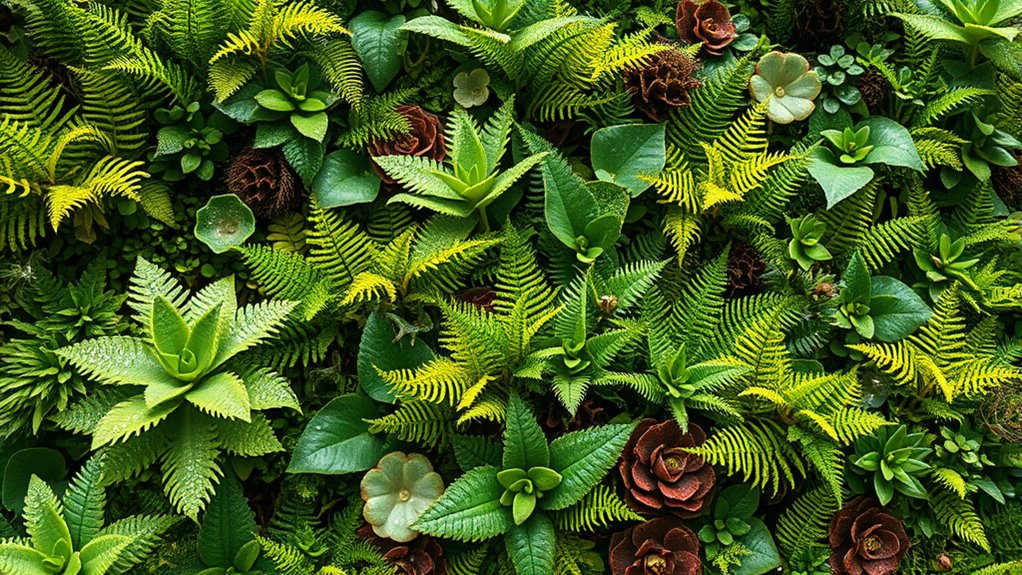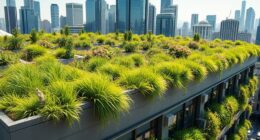To maintain a living wall, you should choose plants suited for vertical growth, such as succulents, ferns, and climbers, and guarantee their water and light needs match. Use an efficient irrigation system like drip or automated setups with moisture sensors to deliver water evenly while reducing waste. Regular pruning, fertilizing, pest checks, and system inspections help keep your wall healthy and vibrant. Keep going to discover detailed tips that will help you create and sustain a stunning green feature.
Key Takeaways
- Choose suitable plants with compatible light, water, and growth habits for system longevity.
- Implement efficient irrigation such as drip systems with moisture sensors for even watering.
- Regularly inspect and maintain irrigation components to prevent clogs, leaks, and ensure proper function.
- Prune, fertilize, and monitor plant health to promote vitality and prevent overgrowth or disease.
- Conduct routine structural and surface inspections to preserve wall integrity and support sustainable growth.

Living walls transform ordinary building facades into vibrant, sustainable ecosystems. They provide a striking visual appeal while also improving air quality, insulating buildings, and promoting biodiversity. To guarantee your living wall thrives, choosing the right plant selection is vital. You want plants that can adapt to vertical growth, withstand varying light conditions, and require minimal maintenance. Opt for a mix of hardy, drought-tolerant species like succulents, ferns, and certain climbing plants, which are well-suited for vertical environments. Incorporate a variety of textures and colors to create visual interest and support local pollinators. When selecting plants, consider their mature size, root structure, and water needs to avoid overcrowding and guarantee they stay healthy over time. Additionally, selecting plants with compatible water and light requirements simplifies ongoing care and ensures a harmonious and resilient living wall.
Equally important is implementing an effective irrigation system. Proper watering is essential for keeping your living wall lush and vibrant. Modern irrigation systems for living walls are designed to deliver water evenly and efficiently, reducing waste and preventing overwatering. Drip irrigation is a popular choice because it delivers water directly to the roots, minimizing evaporation and runoff. You might also consider automatic systems equipped with moisture sensors that monitor soil moisture levels and adjust watering schedules accordingly. This automation helps you conserve water and reduces the need for manual intervention. Guarantee your irrigation setup covers all areas of the wall uniformly, especially if you have a diverse plant palette with varying water needs. Regularly inspect the system for clogs or leaks, and adjust the watering frequency seasonally to match the plants’ growth cycle and environmental conditions. Maintaining a consistent watering schedule supports the health and longevity of your living wall.
Maintaining your living wall involves more than just watering. You’ll need to prune and trim plants to prevent overgrowth and remove any dead or diseased foliage. Periodic fertilization supports healthy growth and vibrant colors, but use a balanced, slow-release fertilizer to avoid overfeeding. Monitoring plant health is key; look for signs of pests or disease early and take swift action to address problems before they spread. Additionally, keep an eye on the irrigation system to guarantee it continues functioning properly, especially after weather changes or heavy storms. Regular maintenance also involves cleaning the wall surfaces and checking the structural integrity of the support system to prevent damage over time. Practicing regular inspections ensures the longevity and beauty of your living wall, making it a sustainable feature that enhances your space’s aesthetics and environment, offering beauty and ecological benefits for years to come.
Frequently Asked Questions
What Are the Environmental Benefits of Living Walls?
Living walls boost urban biodiversity by providing habitats for birds, insects, and plants, helping to restore ecological balance. They also enhance aesthetics, making your surroundings more visually appealing. By reducing heat and improving air quality, living walls contribute to a healthier environment. You’ll notice a more vibrant, inviting space that supports local ecosystems while elevating the overall look of your building or community.
How Do Living Walls Impact Indoor Air Quality?
Imagine stepping into a room that feels invigorating—living walls actively improve indoor air quality by filtering out pollutants through air filtration. They also help regulate humidity levels, preventing stuffiness and mold. This natural system creates a healthier environment, much like an old-school greenhouse. You’ll notice better air circulation, fewer allergens, and a more comfortable space, making your indoor experience both revitalizing and wholesome.
Are There Specific Plants Better Suited for Living Walls?
You should prioritize plant selection based on your living wall’s environment and your maintenance considerations. Opt for hardy, low-maintenance plants like succulents, ferns, or pothos that thrive indoors or in shaded areas. These plants are better suited because they require less frequent watering and care. Consider your space, light, and humidity levels to choose the right species, ensuring your living wall stays vibrant and healthy with manageable maintenance.
What Is the Typical Lifespan of a Living Wall System?
Think of your living wall as a thriving garden heartbeat, beating strong for 10-15 years with proper plant maintenance and thoughtful system durability. Regular upkeep nurtures its importance, much like tending to a cherished friend. While the structure’s lifespan varies, investing in quality materials and timely care ensures your living wall stays lush and resilient, symbolizing growth and longevity in your space. Keep it healthy, and it’ll flourish for years to come.
How Do Living Walls Affect Building Energy Efficiency?
Living walls boost your building’s energy efficiency by providing insulation benefits and aiding thermal regulation. They help keep indoor temperatures stable, reducing the need for heating and cooling. This natural insulation minimizes energy consumption, lowers utility bills, and decreases your carbon footprint. By integrating living walls, you create a more sustainable, comfortable environment, enhancing overall building performance while supporting eco-friendly design practices.
Conclusion
Living walls breathe life into your space, turning bare walls into lush, green masterpieces. With proper systems and regular maintenance, they flourish like a vibrant jungle in your home or office. Think of your living wall as a living canvas, constantly evolving and thriving under your care. By nurturing it, you create a breathtaking oasis that not only beautifies but also refreshes your environment. Embrace the green touch, and watch your space bloom with energy.










